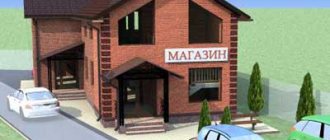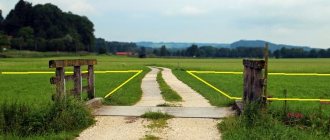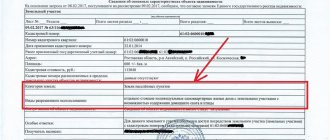Residents of rural outskirts will be interested in the possibility of expanding their homesteads, and city residents will be interested in realizing the dream of the cherished six hundred square meters for growing fresh herbs and vegetables.
When translation is needed
Agricultural sites, depending on the purpose of use, may completely prohibit the construction of permanent structures or allow the construction of temporary buildings and utility rooms intended for the storage and production of agricultural products.
If you intend to legalize a house for living on agricultural land, you must assign the allotment VRI LPH (homestead plot), if for some reason the individual housing construction is not suitable for you.
The planned sale of a land plot or its use as a collateral fund is an economically significant reason for transferring the plot of land to private household plots.
It will not be possible to legally build a bathhouse on agricultural land without transferring the site to private household plots. Such an object cannot be recognized as an agricultural building.
The desire to organize small agricultural production with the help of family members is another reason for transferring land from agricultural use to private household plots.
A pleasant bonus of such a transfer is the absence of the need to pay taxes and fees on income received from the sale of manufactured products. This form of enterprise organization as a peasant farm does not have such an advantage.
The procedure for changing the VRI of a plot to a “LPH” may not be required if you are interested in the possibility of building and registering housing on the land, given the existing permitted use of your plot:
- Dacha farming . Read about the possibilities of construction on dacha land in the article.
- Garden community . Read the article about options for using garden land.
Features of transferring agricultural land to private plots
To transfer land to private household plots, it is necessary to take into account that plots that are allocated for subsidiary plots have maximum areas, the size of which depends on the location of the plot. There are questions related to the feasibility and complexity of transferring land for private plots. After all, a situation may arise in which there are no options for a new type of permitted use, or approval may take quite a long time.
Transfer to private household plots has the advantage of being able to sell the products grown.
While only the owner and his relatives can engage in agriculture without the involvement of hired workers. Citizens have the right to sell surplus products without taxation, since such activities are not subject to tax expenditures.
Transferring land to private household plots makes it possible to obtain a certificate for products, a certificate from a veterinary institution, other official documents for selling products at various retail outlets, etc.
Often, the transfer of land to private household plots is used by those owners of agricultural land who have limited opportunities for their use. For example, if the land is intended only for a garden, vegetable garden or farming, then by changing the VRI, you can engage in any type of agricultural activity.
Regarding urban lands, their transfer to private household plots helps to grow and sell products without paying excessive taxes. This is especially true for the reason that the rate for private household plots is several times lower than for individual housing construction, which brings significant savings.
Features of assigning VRI personal subsidiary plot
Allotments with permitted use for personal subsidiary plots can be located both on agricultural lands and on settlement lands.
In the first case, these will be field plots, in the second - household plots.
To assign a plot of land the status of a household plot, a change in the category of land will be required.
The authorized bodies will grant the request subject to the following conditions :
- Low quality of the site.
- No illegal buildings on the land.
- Consent of all owners of agricultural real estate.
- The location of the site is near a populated area.
If the land is owned (used) by the participants of the partnership:
- country house,
- garden,
- gardening,
a positive decision of the general meeting will be required to change the category of the general land mass with a subsequent change in the purpose of its use.
When an agricultural plot is assigned field status, permission is granted at the municipal level .
You can clarify the procedure for assigning a VRI “LPH” to an agricultural plot by sending a corresponding request to the settlement administration or the Rosreestr department.
Plots related to agricultural land are subject to a special legal regime. In particular, the use of such sites for development purposes is not permissible.
Why is distribution needed?
Such division is necessary to protect the land fund from illegal use. On some lands it is allowed to build residential buildings and various outbuildings, on others - only to engage in agriculture.
If activities are carried out on the site that contradict its possible exploitation, then this is a violation of the law.
Therefore, when the owner needs to use his plot in a way that the category assigned to it does not suggest, he is faced with the task of transferring the land from one category to another. The legislation allows for the possibility of changing the category of a site subject to certain legal conditions.
The procedure for transferring land from one category to another is regulated by the norms of the Land and Town Planning Code and Federal Law No. 172, which deals with the procedure for changing the category of land plots.
How does the re-registration take place?
The decision to change the category of land is made at the regional government level. The authorized body to receive applications from the population and legal entities to change the category and VRI of land is the municipal administration.
The following documents must be attached to the application :
- Applicant's passport.
- Documents confirming ownership of the plot. If the land is not properly registered, then before the procedure for changing the VRI (category) begins, it will be necessary to measure the plot, register it in the cadastral register and register the rights to it.
- Extract from the Unified State Register of Real Estate.
- Written justification for the reason for changing the category of land.
When a land tenant submits an application, confirmation of the owner’s consent is required.
Read more about changing the category of land in the article.
The assignment of VRI “LPH” within one category of land
is carried out according to a simplified procedure .
Here you can do without an environmental assessment of the land and other time-consuming procedures.
The application with a package of supporting documents is submitted to a commission created under the administration of the settlement, where it is considered within thirty days.
Read more about changing the VRI of a site in the feature article.
In cases where there are no plans to erect permanent buildings on the site, then obtaining permission to conduct a subsidiary plot can be neglected.
Types of land plots - advantages and disadvantages of individual housing construction and private plots
The category of land is not only a distinction by purpose, but also a determination of legal status.
The legal status of land allows its owner to use the land in one way or another:
- as an area for the construction of structures;
- as a natural resource for profit and other material benefits.
Thus, for the construction of buildings and structures, including residential buildings, citizens are allocated the category of individual housing construction land. It is provided within populated areas with the ability to connect to utility networks.
In turn, the category of private household plots is reserved for farming:
- gardening;
- gardening;
- livestock breeding.
All this is briefly called subsidiary farming. Today, in practice, land for farming is provided in the form of plots in SNT, summer cottages, etc. But this status of the land does not mean that you cannot build there. It will be difficult to simply design such a structure, especially a residential building, which in the future must be connected to utility lines.
How to transfer agricultural land for dacha construction ? To do this, you will need to submit an application to the local administration.
However, today only those plots that are located within cooperatives or were originally allocated for these purposes are registered as dacha farms.
Cost of the procedure
Changing the status of a land plot is possible in relation to objects registered in the cadastral register. To do this, it is necessary to measure the plot and send the obtained geodetic data about the plot to the Cadastral Chamber for entering information about it into the Land Cadastre.
The cost of this procedure is on average 10 thousand rubles . and depends on the appetites of the cadastral engineer.
An extract from the Unified State Register contains basic information about the property, including rights to it. The minimum cost for a document in electronic form is 300-600 rubles .
When obtaining consent to change the VRI (category) of land, changes will be required to the state cadastre . In the event that the changes are not sent to Rosreestr by the municipality, the cost of the service for citizens will be from 245 to 350 rubles , for legal entities - from 700 to 1000 rubles.
Interaction with official structures can be entrusted to a specialist. The cost of legal support in some situations reaches 50 thousand rubles.
How to convert agricultural land into private household plots
In order to transfer a plot of land for private plots, it is necessary that it meets the requirements of federal legislation and the rules for land use and development established in the regions. It is necessary to establish minimum and maximum plot sizes in a given territory. At the same time, rules regarding zoning and environmental protection zones must not be violated.
Before the procedure for changing the permitted use begins, it is necessary to go through all stages of approval from local authorities, including the architectural department and the committee in charge of land use.
If civilians or individuals have a need for commercial farming, they can be allocated any plots of land of a certain category. But the limits of non-profit private household plots are quite limited. The largest sizes of plots must be obtained from the regional administration.
Most often, citizens receive 1 or 2 hectares of land for private plots. In rare cases, areas of up to 8 hectares can be allocated. The sizes are determined by the local administration independently.
First you need to find all the information relating to the territory. This includes information about environmental protection zones, the degree of pollution, and others. In addition to studies on the zoning of the site, various approvals need to be carried out. Afterwards, all the necessary documentation is collected and an application is submitted. After this, you need to contact local authorities and wait for the results.
A set of all papers is thoroughly checked, including copies of documents that confirm the identity of the applicant, because they are not the same for individuals, legal entities and entrepreneurs, for example, information from the cadastral and registration authorities, a permit confirming the owner’s consent to transfer the land, etc. The application must have the land number from the cadastral register, the grounds on which the transfer is made, the applicant’s data, the current category of land, VRI.
Remember: you can save time by using the services of experienced specialists in this matter.
Registration of private household plots is mandatory if citizens want to sell self-produced goods in accordance with the law. But the sale of private household products does not require the payment of taxes. Private household plots have a significant advantage over other agricultural producers. Therefore, you need to use it.
Reasons for refusal
An exhaustive list of reasons for refusing to satisfy an application is given in the administrative regulations for the provision of municipal (state) services.
Typically this is:
- Incomplete package of required documents.
- Lack of justification for the request.
- Identified errors in documents.
After correcting the errors identified by the commission, you have the right to re-submit your application .
The fatal reason is the conflict of the applicant’s intentions with the existing urban development plan, the initiation of a procedure in relation to particularly valuable lands.
VRI individual housing construction
Individual housing construction is allowed on the lands of populated areas, where this is permitted by the current town planning regulations. On individual housing construction plots, the construction of a low-rise residential building (within three floors) is permitted, which does not allow division into apartments and is suitable for one family. Central communications must be provided to this building by the local administration.
Also, on an individual housing construction site, you can build not only a permanent structure for year-round living, but also grow agricultural crops (fruits, melons, berries, ornamental, etc.), place garages and utility buildings for keeping farm animals.
Rent of land for gardening
a plot of land leased for 25 years for gardening (settlement lands) has been assigned a geographic address, is registered in the cadastral register in the Rosreestr, leased from 2021 from 2021, the lease was extended for 25 years. On the left and on the right are neighbors plots for individual housing construction
Can I lease the land adjacent to my plot for gardening?
They are refusing to extend the lease of a land plot. Until 2021, there was an easement between the plots. At my request, it was removed and while new documents were being prepared, the lease period had expired and now they are refusing to extend the lease, citing the term of the contract.
If the land for gardening is in a non-profit partnership, then it can be registered as ownership free of charge if the city authorities provided the territory to this partnership before October 2001. To register a plot of land, you will need the following documents:
The application is considered within a month, during which employees of the land management department make a decision on whether to provide ownership of the plot for gardening or to refuse it.
Changing the VRI of a city site
Land plots intended for agricultural activities may have different purposes, which determine the types of permitted use of such plots. Possible activities on plots for gardening depend on the category of land to which they belong and the zonal distribution in the area.
We recommend reading: Minimum tariff rate for a 1st category worker in the Moscow region in 2021 from January 1
In 2021, amendments were introduced to the Land Code of the Russian Federation that simplified the procedure for purchasing land for private plots. Now a plot can be obtained without a preliminary auction. The purchase is carried out depending on the cadastral value. Such a plot can be obtained by both individuals and legal entities.
The lease agreement in this case is drawn up for 3 years. By the end of this period, the house must be built and put into operation. Then you can apply to register the plot as private property. In case of initial application, the land is transferred free of charge. If you have already received a plot of land previously, you can resort to paid registration.
Plot for individual housing construction
- Specially protected areas, including nature reserves and national parks;
- Forest fund lands;
- Public areas;
- Lands allocated for the needs of the Armed Forces of the Russian Federation;
- Land allocated for state needs.
Farming and living on the territory of a horticultural or gardening association is possible without participating in it. Citizens who are not members of the partnership must make all payments approved by the board, have the right to use common property and participate in voting on most issues. The exception is non-participation in the elections of the chairman and members of the board.











